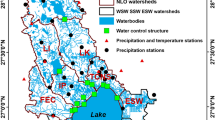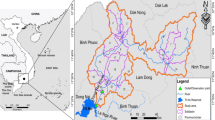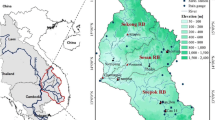Abstract
This study applied catchment modeling to examine the potential effects of climate change and future land management variations on streamflow and microbial transport sensitivities for two locations in the west of Ireland (Black River and Fergus River). Simulations focused on plausible combined scenarios of climate, population and agricultural production variations for the 2041–2060 period and compares resultant impacts to a baseline existing period (1994–2007). The variations in monthly, seasonal and annual streamflow, and the daily microbial load (for E. coli) were used to assess sensitivities. Results indicate that possible future changes in microbial load for both the Fergus and Black catchments typically follow projected seasonal fluctuations in precipitation and streamflow. Increased winter rainfall (intensity and frequency) will cause significant impacts on microbial transport, representing a period of increased risk. An increase in microbial source loads to land, concomitantly with projected changes in climate is likely to exert greater microbial pollutant pressures on surface waters. The simulated scenarios, and resultant microbial load changes, suggest that future variations in land use/management may be as important as the effects of climate change on in-stream microbial pollutant loads. Outcomes from this study can prove useful for informing water resource managers and other decision makers about potential impacts. This information can instigate the development of adaptation measures needed to alleviate increased catchment pollution from microbial contaminants (and other pollutants) in future years.







Similar content being viewed by others
References
Ahmadi M, Records R, Arabi M (2014) Impact of climate change on diffuse pollutant fluxes at the watershed scale. Hydrol Process 28:1962–1972. doi:10.1002/hyp.9723
Arnold JG, Fohrer N (2005) SWAT2000: current capabilities and research opportunities in applied watershed modelling. Hydrol Process 19:563–572. doi:10.1002/hyp.5611
Baffaut C, Sadeghi A (2010) Bacteria modeling with SWAT for assessment and remediation studies: a review. Trans ASABE 53:1585–1594. doi:10.13031/2013.34907
Bell A, Zhu T, Xie H, Ringler C (2014) Climate–water interactions—challenges for improved representation in integrated assessment models. Energy Econ. doi:10.1016/j.eneco.2013.12.016
Benham B, Baffaut C, Zeckoski RW, Mankin KR, Pachepsky YA, Sadeghi AM, Brannan KM, Soupir ML, Habersack MJ (2006a) Modeling bacteria fate and transport in watersheds to support TMDLs. Trans ASABE 49:987–1002. doi:10.13031/2013.20783
Benham BL, Zeckoski RW, Mishra A (2006b) Bacteria Total Maximum Daily Load Development for Pigg River, Snow Creek, Story Creek, and Old Womans Creek. Virginia Tech. http://www.deq.virginia.gov/portals/0/DEQ/Water/TMDL/apptmdls/roankrvr/piggec.pdf. Accessed May 2014
Butcher J, Parker A, Johnson T, Weaver C (2010) Nationwide watershed modeling to evaluate potential impacts of climate and land use change on hydrology and water quality. In: Watershed Management 2010. American Society of Civil Engineers, pp 1350–1361. doi:10.1061/41143(394)121
Candela L, Tamoh K, Olivares G, Gomez M (2012) Modelling impacts of climate change on water resources in ungauged and data-scarce watersheds. Application to the Siurana catchment (NE Spain). Sci Total Environ 440:253–260. doi:10.1016/j.scitotenv.2012.06.062
Chin D (2011) Quantifying Pathogen Sources in Streams by Hydrograph Separation. J Environ Eng 137(9):770–781. doi:10.1061/(ASCE)EE.1943-7870.0000394
Chin DA, Sakura-Lemessy D, Bosch DD, Gay PA (2009) Watershed-scale fate and transport of bacteria. Trans ASABE 52(1):145–154
Chien H, Yeh PJF, Knouft JH (2013) Modeling the potential impacts of climate change on streamflow in agricultural watersheds of the Midwestern United States. J Hydrol 491:73–88. doi:10.1016/j.jhydrol.2013.03.026
Christensen N, Lettenmaier DP (2006) A multimodel ensemble approach to assessment of climate change impacts on the hydrology and water resources of the Colorado River basin. Hydrol Earth Syst Sci Discuss 3:3727–3770. doi:10.5194/hessd-3-3727-2006
Coffey R, Cummins E, Cormican M, Flaherty VO, Kelly S (2007) Microbial exposure assessment of waterborne pathogens. Hum Ecol Risk Assess 13(6):1313–1351
Coffey R, Cummins E, Bhreathnach N, Flaherty VO, Cormican M (2010) Development of a pathogen transport model for Irish catchments using SWAT. Agric Water Manag 97:101–111. doi:10.1016/j.agwat.2009.08.017
Coffey R, Dorai-Raj S, O’Flaherty V, Cormican M, Cummins E (2013) Modeling of pathogen indicator organisms in a small-scale agricultural catchment using SWAT. Hum Ecol Risk Assess Int J 19(1):232–253. doi:10.1080/10807039.2012.701983
Coffey R, Benham B, Krometis L-A, Wolfe ML, Cummins E (2014) Assessing the effects of climate change on waterborne microorganisms: implications for EU and US Water Policy. Hum Ecol Risk Assess Int J 20:724–742. doi:10.1080/10807039.2013.802583
Coffey R, Benham B, Kline K, Wolfe ML, Cummins E (2015) Modeling the impacts of climate change and future land use variation on microbial transport. Water Clim Change 6:23. doi:10.2166/wcc.2015.049
CSO (2013) Principal CSO Agriculture Statistics. http://www.cso.ie/en/statistics/agricultureandfishing/. Accessed April 2014
Delpla I, Jung AV, Baures E, Clement M, Thomas O (2009) Impacts of climate change on surface water quality in relation to drinking water production. Environ Int 35:1225–1233. doi:10.1016/j.envint.2009.07.001
Dessai S, Hulme M (2007) Assessing the robustness of adaptation decisions to climate change uncertainties: a case study on water resources management in the East of England. Glob Environ Change 17:59–72. doi:10.1016/j.gloenvcha.2006.11.005
Dorai-Raj S, Grady JO, Colleran E (2009) Specificity and sensitivity evaluation of novel and existing Bacteroidales and Bifidobacteria-specific PCR assays on feces and sewage samples and their application for microbial source tracking in Ireland. Water Res 43:4980–4988. doi:10.1016/j.watres.2009.08.050
Dunn SM, Brown I, Sample J, Post H (2012) Relationships between climate, water resources, land use and diffuse pollution and the significance of uncertainty in climate change. J Hydrol 434–435:19–35. doi:10.1016/j.jhydrol.2012.02.039
Dunne S, Hanafin J, Lynch P, McGrath R, Nishimura E, Nolan P, Venkata Ratnam J, Semmler T, Sweeney C, Varghese S, Wang S (2009) Ireland in a Warmer World—scientific predictions of the Irish climate in the twenty-first century. Environmental Protection Agency, Met Éireann and University College Dublin. http://www.epa.ie/pubs/reports/research/climate/STRIVE_27_Dunne_C4I_web.pdf. Accessed May 2014
ECARD (2010) Prospects for agricultural markets and income in the EU. http://www.eurocarne.com/daal?a1=informes&a2=fullrep_en.pdf. Accessed May 2014
Eurostat (2014) Agricultural production. European Commission. http://epp.eurostat.ec.europa.eu/portal/page/portal/agriculture/agricultural_production/database. Accessed May 2014
Ficklin DL, Luo Y, Luedeling E, Zhang M (2009) Climate change sensitivity assessment of a highly agricultural watershed using SWAT. J Hydrol 374:16–29. doi:10.1016/j.jhydrol.2009.05.016
Ficklin DL, Luo Y, Luedeling E, Gatzke SE, Zhang M (2010) Sensitivity of agricultural runoff loads to rising levels of CO2 and climate change in the San Joaquin Valley watershed of California. Environ Pollut 158:223–234. doi:10.1016/j.envpol.2009.07.016
Ficklin D, Stewart I, Maurer E (2013) Effects of projected climate change on the hydrology in the Mono Lake Basin. California Climatic Change 116:111–131. doi:10.1007/s10584-012-0566-6
Fowler H, Blenkinsop S, Tebaldi C (2007) Linking climate change modelling to impacts studies: recent advances in downscaling techniques for hydrological modelling. Int J Climatol 27:1547–1578. doi:10.1002/joc.1556
Frey SK, Topp E, Edge T, Fall C, Gannon V, Jokinen C, Lapen DR (2013) Using SWAT, Bacteroidales microbial source tracking markers, and fecal indicator bacteria to predict waterborne pathogen occurrence in an agricultural watershed. Water res 47(16):6326–6337
Gardiner MJ, Radford T (1980) Soil associations of Ireland and their land use potential. Explanatory Bulletin to the Soil Map of Ireland 1980. Soil Survey Bulletin No. 36. Dublin. http://www.agresearch.teagasc.ie/johnstown/Soil%20maps/General%20Soils%20map/Book.pdf. Accessed may 2014
Gleeson E, McGrath R, Treanor M (2013) Ireland’s climate: the road ahead. Met Éireann, Dublin
Gray N (2014) Chapter thirty-six—The implications of global warming and climate change on waterborne diseases. In: Percival SL, Yates MV, Williams DW, Chalmers RM, Gray NF (eds) Microbiology of waterborne diseases, 2nd edn. Academic Press, London, pp 653–666. doi:10.1016/B978-0-12-415846-7.00036-6
Groisman PY, Knight RW, Easterling DR, Karl TR, Hegerl GC, Razuvaev VN (2005) Trends in intense precipitation in the climate record. J Clim 18:1326–1350. doi:10.1175/JCLI3339.1
Hampson D, Crowther J, Bateman I, Kay D, Posen P, Stapleton C, Wyer M, Fezzi C, Jones P, Tzanopoulos J (2010) Predicting microbial pollution concentrations in UK rivers in response to land use change. Water Res 44:4748–4759. doi:10.1016/j.watres.2010.07.062
Hay LE, Wilby RL, Leavesley GH (2000) A comparison of delta change and downscaled GCM scenarios for three mountainous basins in the United States. J Am Water Resour Assoc 36:387–397. doi:10.1111/j.1752-1688.2000.tb04276.x
Hofstra N (2011) Quantifying the impact of climate change on enteric waterborne pathogen concentrations in surface water. Curr Opin Environ Sustain 3:471–479. doi:10.1016/j.cosust.2011.10.006
IPCC (2007) Summary for Policymakers. In: Climate Change 2007: The Physical Science Basis. Contribution of Working Group I to the Fourth Assessment Report of the Intergovernmental Panel on Climate Change [Solomon, S., D. Qin, M. Manning, Z. Chen, M. Marquis, K.B. Averyt, M.Tignor and H.L. Miller (eds.)]. Cambridge University Press, Cambridge, United Kingdom and New York, NY, USA
Iudicello JJ, Chin DA (2014) In-stream bacteria modeling as a function of the hydrologic state of a watershed. J Environ Eng 141(4):04014073
Jamieson RC, Gordon RJ, Tattrie SC, Stratton GW (2003) Sources and persistence of fecal coliform bacteria in a rural watershed. Water Qual Res J Canada 38(1):33–47
Jayakody P, Parajuli PB, Brooks JP (2014) Assessing climate variability impact on thermotolerant coliform bacteria in surface water. Hum Ecol Risk Assess Int J. doi:10.1080/10807039.2014.909188
Jennings E, Allott N, Pierson DC, Schneiderman EM, Lenihan D, Samuelsson P, Taylor D (2009) Impacts of climate change on phosphorus loading from a grassland catchment: implications for future management. Water Res 43:4316–4326. doi:10.1016/j.watres.2009.06.032
Johnson T, Weaver C (2009) A framework for assessing climate change impacts on water and watershed systems. Environ Manag 43:118–134. doi:10.1007/s00267-008-9205-4
Johnson T, Butcher J, Parker A, Weaver C (2011) Investigating the sensitivity of U.S. streamflow and water quality to climate change: U.S. EPA Global Change Research Program’s 20 Watersheds Project. J Water Resour Plan Manag 138:453–464. doi:10.1061/(ASCE)WR.1943-5452.0000175
Kim SM, Benham BL, Brannan KM, Zeckoski RW, Yagow GR (2007) Water quality calibration criteria for bacteria TMDL development. Appl Eng Agric 23:6. doi:10.13031/2013.22610
Kim JW, Pachepsky YA, Shelton DR, Coppock C (2010) Effect of streambed bacteria release on E. coli concentrations: monitoring and modeling with the modified SWAT. Ecol Model 221(12):1592–1604. doi:10.1016/j.ecolmodel.2010.03.005
Kundzewicz ZW, Mata LJ, Arnell NW, Döll P, Kabat P, Jiménez B, Miller KA, Oki T, Sen Z, Shiklomanov IA (2007) Freshwater resources and their management. In: Parry ML, Canziani OF, Palutikof JP, van der Linden PJ, Hanson CE (eds) Climate Change 2007: impacts, adaptation and vulnerability. Cambridge University Press, Cambridge, pp 173–210
Kundzewicz ZW, Mata LJ, Arnell NW, Doll P, Jimenez B, Miller K, Oki T, Sen Z, Shiklomanov I (2008) The implications of projected climate change for freshwater resources and their management. Hydrol Sci J 53:3–10. doi:10.1623/hysj.53.1.3
Larsen MC, Hamilton PA, Werkheiser WH (2013) Water quality status and trends in the United States. In: Ahuja S (ed) Monitoring water quality. Elsevier, Amsterdam, pp 19–57. doi:10.1016/B978-0-444-59395-5.00002-9
Lee E, Seong C, Kim H, Park S, Kang M (2010) Predicting the impacts of climate change on nonpoint source pollutant loads from agricultural small watershed using artificial neural network. J Environ Sci 22:840–845. doi:10.1016/S1001-0742(09)60186-8
Liu Z, Tong STY (2011) Using HSPF to model the hydrologic and water quality impacts of riparian land-use change in a small watershed. J Environ Inf 17:1–14. doi:10.3808/jei.201100182
Lopez SR, Hogue TS, Stein ED (2013) A framework for evaluating regional hydrologic sensitivity to climate change using archetypal watershed modeling. Hydrol Earth Syst Sci 17:3077–3094. doi:10.5194/hess-17-3077-2013
Luo Y, Ficklin DL, Liu X, Zhang M (2013) Assessment of climate change impacts on hydrology and water quality with a watershed modeling approach. Sci Total Environ 450–451:72–82. doi:10.1016/j.scitotenv.2013.02.004
Marti R, Gannon VP, Jokinen C, Lanthier M, Lapen DR, Neumann NF, Ruecker NJ, Scott A, Wilkes G, Zhang Y, Topp E (2013) Quantitative multi-year elucidation of fecal sources of waterborne pathogen contamination in the South Nation River basin using Bacteroidales microbial source tracking markers. Water Res 47:2315–2324. doi:10.1016/j.watres.2013.02.009
Moriasi DN, Arnold JG, Van Liew MW, Bingner RL, Harmel RD, Veith TL (2007) Model evaluation guidelines for systematic quantification of accuracy in watershed simulations. Trans ASABE 50:16. doi:10.13031/2013.23153
Moss RH, Edmonds JA, Hibbard KA, Manning MR, Rose SK, van Vuuren DP, Carter TR, Emori S, Kainuma M, Kram T, Meehl GA, Mitchell JF, Nakicenovic N, Riahi K, Smith SJ, Stouffer RJ, Thomson AM, Weyant JP, Wilbanks TJ (2010) The next generation of scenarios for climate change research and assessment. Nature 463:747–756. doi:http://www.nature.com/nature/journal/v463/n7282/suppinfo/nature08823_S1.html
Nardone A, Ronchi B, Lacetera N, Ranieri MS, Bernabucci U (2010) Effects of climate changes on animal production and sustainability of livestock systems. Livest Sci 130:57–69. doi:10.1016/j.livsci.2010.02.011
New M, Lopez A, Dessai S, Wilby R (2007) Challenges in using probabilistic climate change information for impact assessments: an example from the water sector. Philos Trans R Soc Lond A Math Phys Eng Sci 365:2117–2131. doi:10.1098/rsta.2007.2080
Olmstead SM (2013) Climate change adaptation and water resource management: a review of the literature. Energy Econ. doi:10.1016/j.eneco.2013.09.005
Oliver DM, Heathwaite AL, Fish RD, Chadwick DR, Hodgson CJ, Winter M, Butler AJ (2009) Scale appropriate modelling of diffuse microbial pollution from agriculture. Prog Phys Geogr 33:358–377
Pandey PK, Soupir ML, Rehmann CR (2012) A model for predicting resuspension of Escherichia coli from streambed sediments. Water Res 46:115–126. doi:10.1016/j.watres.2011.10.019
Parajuli PB, Mankin KR, Barnes PL (2009) Source specific fecal bacteria modeling using soil and water assessment tool model. Bioresour Technol 100(2):953–963
Patz JA, Campbell-Lendrum D, Holloway T, Foley JA (2005) Impact of regional climate change on human health. Nature 438:310–317. doi:10.1038/nature04188
Pruss A, Kay D, Fewtrell L, Bartram J (2002) Estimating the burden of disease from water, sanitation, and hygiene at a global level. Environ Health Perspect 110:537–542. http://www.who.int/quantifying_ehimpacts/global/en/ArticleEHP052002.pdf. Accessed May 2014
Quevauviller P (2011) Adapting to climate change: reducing water-related risks in Europe—EU policy and research considerations. Environ Sci Policy 14:722–729. doi:10.1016/j.envsci.2011.02.008
Rehana S, Mujumdar PP (2012) Climate change induced risk in water quality control problems. J Hydrol 444–445:63–77. doi:10.1016/j.jhydrol.2012.03.042
Sadeghi A, Arnold JG (2002) A SWAT/microbial submodel for predicting pathogen loadings in surface and groundwater at watershed and basin scales. Paper presented at the Total Maximum Daily Load (TMDL) Environmental Regulations: Proceedings of the Conference, Fort Worth, Texas, USA, March 11–13, 2002. doi:10.13031/2013.7529
St Laurent J, Mazumder A (2014) Influence of seasonal and inter-annual hydro-meteorological variability on surface water fecal coliform concentration under varying land-use composition. Water Res 48:170–178. doi:10.1016/j.watres.2013.09.031
Tang J, McDonald S, Peng X, Samadder SR, Murphy TM, Holden NM (2011) Modelling cryptosporidium oocysts transport in small ungauged agricultural catchments. Water res 45(12):3665–3680
Tong STY, Chen W (2002) Modeling the relationship between land use and surface water quality. J Environ Manag 66:377–393. doi:10.1006/jema.2002.0593
Tong STY, Sun Y, Ranatunga T, He J, Yang YJ (2012) Predicting plausible impacts of sets of climate and land use change scenarios on water resources. Appl Geogr 32:477–489. doi:10.1016/j.apgeog.2011.06.014
Vermeulen L, Hofstra N (2014) Influence of climate variables on the concentration of Escherichia coli in the Rhine, Meuse, and Drentse Aa during 1985–2010. Reg Environ Change 14:307–319. doi:10.1007/s10113-013-0492-9
Villarini G, Strong A (2014) Roles of climate and agricultural practices in discharge changes in an agricultural watershed in Iowa. Agric Ecosyst Environ 188:204–211. doi:10.1016/j.agee.2014.02.036
Walsh CJ, Roy AH, Feminella JW, Cottingham PD, Groffman PM, Morgan RP (2005) The urban stream syndrome: current knowledge and the search for a cure. J North Am Benthol Soc 24:706–723. doi:10.1899/04-028.1
Whitehead PG, Wilby RL, Battarbee RW, Kernan M, Wade AJ (2009) A review of the potential impacts of climate change on surface water quality. Hydrol Sci J 54:101–123. doi:10.1623/hysj.54.1.101
Wilby RL, Dessai S (2010) Robust adaptation to climate change. Weather 65(7):180–185. doi:10.1002/wea.543
Wu Y, Liu S, Gallant AL (2012) Predicting impacts of increased CO2 and climate change on the water cycle and water quality in the semiarid James River Basin of the Midwestern USA. Sci Total Environ 430:150–160. doi:10.1016/j.scitotenv.2012.04.058
Acknowledgments
The authors acknowledge funding under the Marie Sklodowska-Curie Actions scheme by Seventh Framework Programme of the European Union.
Author information
Authors and Affiliations
Corresponding author
Additional information
Editor: Erica Smithwick.
Electronic supplementary material
Below is the link to the electronic supplementary material.
Rights and permissions
About this article
Cite this article
Coffey, R., Benham, B., Wolfe, M.L. et al. Sensitivity of streamflow and microbial water quality to future climate and land use change in the West of Ireland. Reg Environ Change 16, 2111–2128 (2016). https://doi.org/10.1007/s10113-015-0912-0
Received:
Accepted:
Published:
Issue Date:
DOI: https://doi.org/10.1007/s10113-015-0912-0




